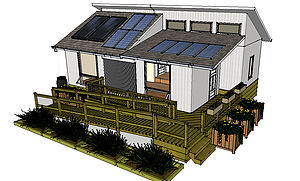Queen’s Solar Design Team – Solar Education Centre

Projects Sponsor
Moving house is always stressful but few of us will ever face the very literal sort of house moving challenge The Solar Design Team at Queen’s University overcame constructing the Queen’s Solar Education Centre (QSEC).
In 2013, The Queen’s Solar Design Team (QSDT) competed in the U.S. Department of Energy’s Solar Decathlon. The team of students built an autonomous house which was shipped to the U.S. for the competition and subsequently dismantled, placing first in Engineering. Following up on that success, the QSDT began their new project, an off-grid modular house in which new ideas, technologies and systems developed by students at Queen’s could be tested. The QSEC, led by project manager Reid Alston, allows ideas to be sourced from students in their Master’s programs and design courses.
The vision for this project — overseen by Dr. Stephen Harrison who has been with the Queen’s Solar Design team since its inception in 1988 — was to build a completely off-grid solar house that supports practical applications of sustainable research, while also educating Queen’s students and the Kingston community.
While construction of the house began in 2011, the actual implementation of most engineering efforts started in early 2015. There were three main systems that needed to be put into place for the house to be livable off-grid, the electrical system, the ventilation and heating system (HVAC), and the water handling system.
The goal of the rain filtration system (begun in late 2014 and near completion) is to catch and filter water, and re-use any shower and sink water for an outside garden. Water is filtered using ultra-violet rays to kill any bacteria. Then, two sediment filters screen out any minerals before the water is brought to the potable water tank.
The electrical system uses roof-top photovoltaic solar panels provide power to charge a 24V, 900 Ah battery bank via an off-the-shelf charge controller system. The battery bank is then used to provide 24V DC and 12V DC power throughout the house as well as 110V AC power via a 3000W pure-sine inverter. DC lighting and appliances are installed and operating and preferred over AC appliances because of the lack of inverters, but both AC and DC power is available for practical purposes. Approximately 3 days of household power relying only on batteries is possible with the current setup.
The ventilation and heating system, which has seen several improvements between 2015 and 2017, pushes the boundaries of off-grid homes. An innovative dual-tank heat system maintains interior temperature year-round. Solar thermal panels heat water which is then used to heat domestic hot water or provide heat for the radiant floor and HVAC systems
As part of its mandate to educate the public on the viability of existing sustainable practices and technologies, the QSDT incorporates educational programming for youth in the city through summer camps and school programming. Between 2015 and 2017 over 8000 people visited the QSEC through open-house programs, public outreach, summer science camps and private tours, inspiring sustainability-minded leaders of the future, those working on the house and those just dropping in.
But really, you’ve been waiting for the “moving house” bit. In 2014, redevelopment at Queen’s required that the house be moved and was it taken nearly two kilometers away by an external company, who rather botched the move. The house was reinstalled with a misaligned main foundation beam. A concrete foundation was laid underneath some parts of the house, making another move very costly. Students were able to work around this problem in 2015 and 2016, filling some gaps in the house with polystyrene foam. Brackets were placed under the middle of the house to support it long term. The team had to brainstorm different ways to seal up the remaining parts of the house, which is important for the innovative heating and ventilation system to work effectively. The team is currently using a combination of different insulation materials and woodworking to seal up the house, while maintaining the aesthetic integrity of the walls so it does not look like it was patched up.
Off-grid solutions and sustainable options will put Canada at the forefront of sustainable innovation in the future, and unquestionably the QSEC is preparing students for their careers, serving as a practical, and sometimes all too real-world means for students to test their engineering education.













